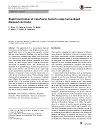The application of a boron-doped diamond electrode in electrochemical water disinfection was investigated with respect to its inactivation potential of three indicator microorganisms. Drinking water and the effluent of a wastewater treatment plant spiked with Escherichia coli, Enterococcus faecium and Pseudomonas aeruginosa were electrolysed under different conditions in a batch reactor. All three bacteria species could be successfully inactivated in drinking water. The disinfection rate depended on the applied charge, with far more efficiency at high current densities (208 and 333 mA/cm2) under high ozone concentrations measured in contrast to low current densities (42 mA/cm2) where bacterial inactivation was rather driven by hydroxyl radicals. When oxidising a target pharmaceutical compound in the wastewater treatment plant effluent, the water matrix exhibited an ozone scavenging effect. The resulting decrease in the efficiency could not be detected for the disinfection experiments in the complex water matrix compared to drinking water, which indicates a different disinfection mechanism, probably due to reactive chlorine species.
